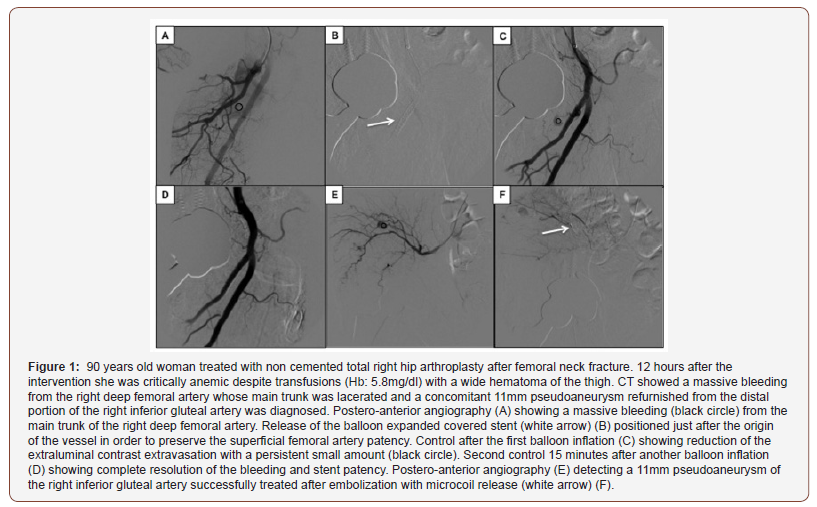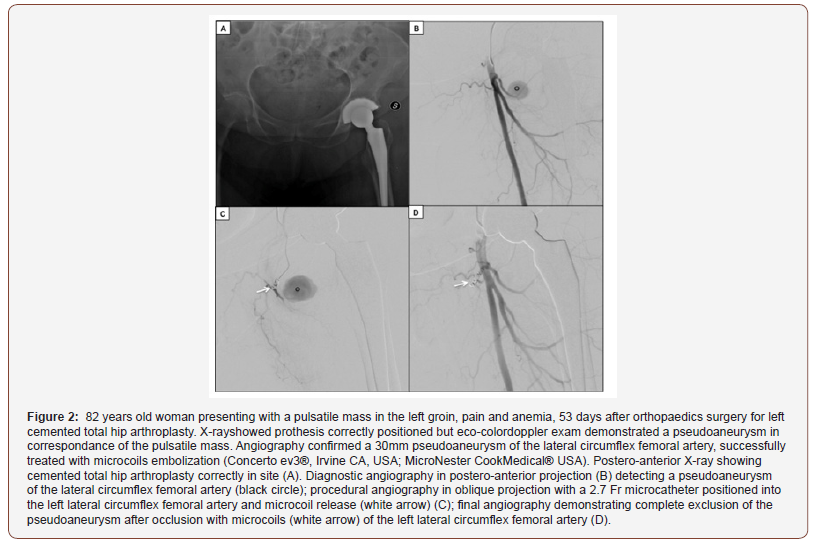 Research Protocol
Research Protocol
Embolizations of Iatrogenic Lower Limb Vascular Injuries after Orthopaedics Surgery
Francesco Giurazza*, Fabio Corvino, Gianluca Cangiano, Errico Cavaglià, Francesco Amodio, Giuseppe De Magistris and Raffaella Niola
Department of Interventional Radiology, Italy
Francesco Giurazza, Department of Interventional Radiology, AORN Cardarelli di Napoli, Italy.
Received Date: November 16, 2018; Published Date: December 10, 2018
Abstract
Introduction: This study aims to evaluate safety and efficacy of endovascular embolizations in a series of patients presenting with arterial vascular injuries of the lower limbs following orthopaedic interventions.
Materials and Methods: Ten patients have been retrospectively enrolled having pulsatile mass, painful lower limb and anemia (hemoglobin <7g/dl).
Result: Vascular lesions were pseudoaneurysm, bleeding with extraluminal contrast agent blush of the terminal arterial segment, laceration and bleeding with extraluminal contrast agent blush of the arterial main trunk. The clinical and procedural technical success was achieved in all cases.
Conclusion: Endovascular embolizations have prooven to be a safe and effective approach to treat arterial vascular lesions occurring after different orthopaedics intervention of the lower limb.
Introduction
Arterial injuries involving lower limbs are rare; main causes are traffic related trauma and iatrogenic lesions during orthopaedics surgical procedures [1]. The clinical manifestations of these injuries typically result in hemorrhagic or ischemic symptoms. Open vascular surgery has been the gold standard in the management of vascular extremity injuries for many years [2] but in the last two decades endovascular techniques have proved to be as effective as open surgery and have been increasingly adopted for treating these lesions [1].
This study focuses on the endovascular embolization treatment of lower limb iatrogenic lesions following orthopaedics surgery. Until today this issue has been discussed in literature mainly in the form of case reports concerning vascular complications of a specific orthopaedic intervention [3-6]; the purpose of this paper is now to evaluate safety and efficacy of endovascular embolization in a series of patients presenting with arterial injuries of the lower limbs following different orthopaedic interventions.
Materials and Methods
In the last 8 years ten patients have been treated with endovascular arterial embolization for iatrogenic vascular lesions occurring after orthopaedics surgery of the lower limb: 4 males and 6 females, mean age of 66 years ranging from 23 to 90 years. Orthopaedics interventions consisted of: 2 gamma nail positioning after intertrochanteric femoral fracture, 3 cemented total hip arthroplasty, 1 non cemented total hip arthroplasty, 1 anterior cruciate ligament reconstruction, 1 femoral stabilization with metallic plate and screws fixation after displaced diaphysis fracture, 1 stabilization of a tibial lateral condyle fracture and 1 tibial stabilization with Ilizarov fixation after displaced diaphysis fracture. Clinical presentations consisted of palpable pulsatile mass, painful and reduced lower limb motion or visible hematoma; eight patients presented also with anemia (hemoglobin <7g/dl).
Result
Interval time between orthopaedics surgery and embolization ranged between 0 and 67 days (mean: 20 days). Overall twelve vessels were injured; in two patients the vessels involved were two, while in eight cases there was a single vessel injured. The injured arterial vessels were: superficial external pudendal artery (1), inferior gluteal artery (1) (Figure 1), deep femoral artery (1) (Figure 1), lateral circumflex femoral artery (2) (Figure 2), medial circumflex femoral artery (1), articular branch of descending genicular artery (1), perforating femoral arteries (3), posterior tibial recurrent artery (1) and anterior tibial artery (1).


The typologies of arterial injury were: pseudoaneurysm 58.3% (7), bleeding with extraluminal contrast agent blush of the terminal arterial segment 25% (3), laceration and bleeding with extraluminal contrast agent blush of the arterial main trunk 16.6% (2). The embolizing agents adopted were microcoils 66.7% (8), glue 8.3% (1), microplug 8.3% (1), particles 8.3% (1), covered stent 8.3% (1). Clinical and technical success was achieved in all cases (100%). No major complications related to the embolization procedure were recorded.
Discussion
Different types of vascular complications have been described in literature after orthopaedics surgery of lower limbs, mainly in form of case reports: vessel laceration, hemorrhage, vascular compression, intimal flap tear, pseudoaneurysm, arteriovenous aneurysm, arterial thromboembolism and ligation [3-6,7], Lesions can be determined by multiple mechanisms: direct acute perforation by an instrument as retractor, screw or scalpel, chronic and slow erosion of a vessel by protruding screws, migration of a loose component, indirect injury resulting from stretching of atherosclerotic or calcified arteries, thermal damage from the polymerisation of cement near to blood vessel [8]. These patients receiving anticoagulants, as subcutaneous heparin, take longer to seal traumatized vessels and are more likely to experience prolonged bleeding. These injuries may be identified intraoperatively, or days to years after the surgery; patients may present with pain, swelling, bleeding, ischemia, or a combination of these symptoms [6].
Conclusion
In this series endovascular embolizations have prooven to be a safe and effective approach to treat arterial vascular lesions occurring after different orthopaedics intervention of the lower limb; orthopaedic surgeons should be aware of the support that interventional radiologists could provide in case of vascular complications.
Acknowledgement
None.
Conflict of Interest
No conflicts of interest.
References
- Maleux G, Herten PJ, Vaninbroukx J, Thijs M, Nijs S, et al. (2012) Value of percutaneous embolotherapy for the management of traumatic vascular limb injury. Acta Radiol 53(2): 147-152.
- Hafez HM, Woolgar J, Robbs JV (2001) Lower extremity arterial injury: results of 550 cases and review of risk factors associated with limb loss. J Vasc Surg 33(6): 1212-9.
- Mello W, De Brito WE, Migon EZ and Borges A (2011) Pseudoaneurysm of the medial inferior genicular artery after anterior cruciate ligament reconstruction. Arthroscopy 27(3): 442-445.
- Sadat U, Naik J, Verma P, See TC, Cousins C, et al. (2008) Endovascular management of pseudoaneurysms following lower limb orthopedic surgery. Am J Orthop 37(5): E99-E102.
- Rachakonda A, Qato K, Khaddash T, Carroccio A, Pamoukian V, et al. (2015) Ultrasound-Guided Thrombin Injection of Genicular Artery Pseudoaneurysm. Ann Vasc Surg 29(5): 1017.e11-1017.e13.
- Huynh S, Kayssi A, Koo K, Rajan D, Safir O, et al. (2016) Avulsion injury to the profunda femoris artery after total hip arthroplasty. J Vasc Surg 64(2): 494-496.
- Barquet A, Gelink A, Giannoudis PV (2015) Proximal femoral fractures and vascular injuries in adults: Incidence, aetiology and outcomes. Injury 46(12):2297-2313.
- Alshameeri Z, Bajekal R, Varty K, Khanduja V (2015) Iatrogenic vascular injuries during arthroplasty of the hip. Bone Joint J 97-B: 1447-55.
-
Francesco Giurazza, Fabio Corvino, Gianluca Cangiano, Errico Cavaglià, Francesco Amodio, Giuseppe De Magistris, Raffaella Niolal. Embolizations of Iatrogenic Lower Limb Vascular Injuries after Orthopaedics Surgery. Arch Clin Case Stud. 1(2): 2018. ACCS.MS.ID.000507.
-
Injury, Ischemic symptoms, Arterial injuries, Orthopedic surgery, Vessel laceration, Hemorrhage, Vascular compression, Pseudoaneurysm, Arteriovenous aneurysm.
-

This work is licensed under a Creative Commons Attribution-NonCommercial 4.0 International License.






